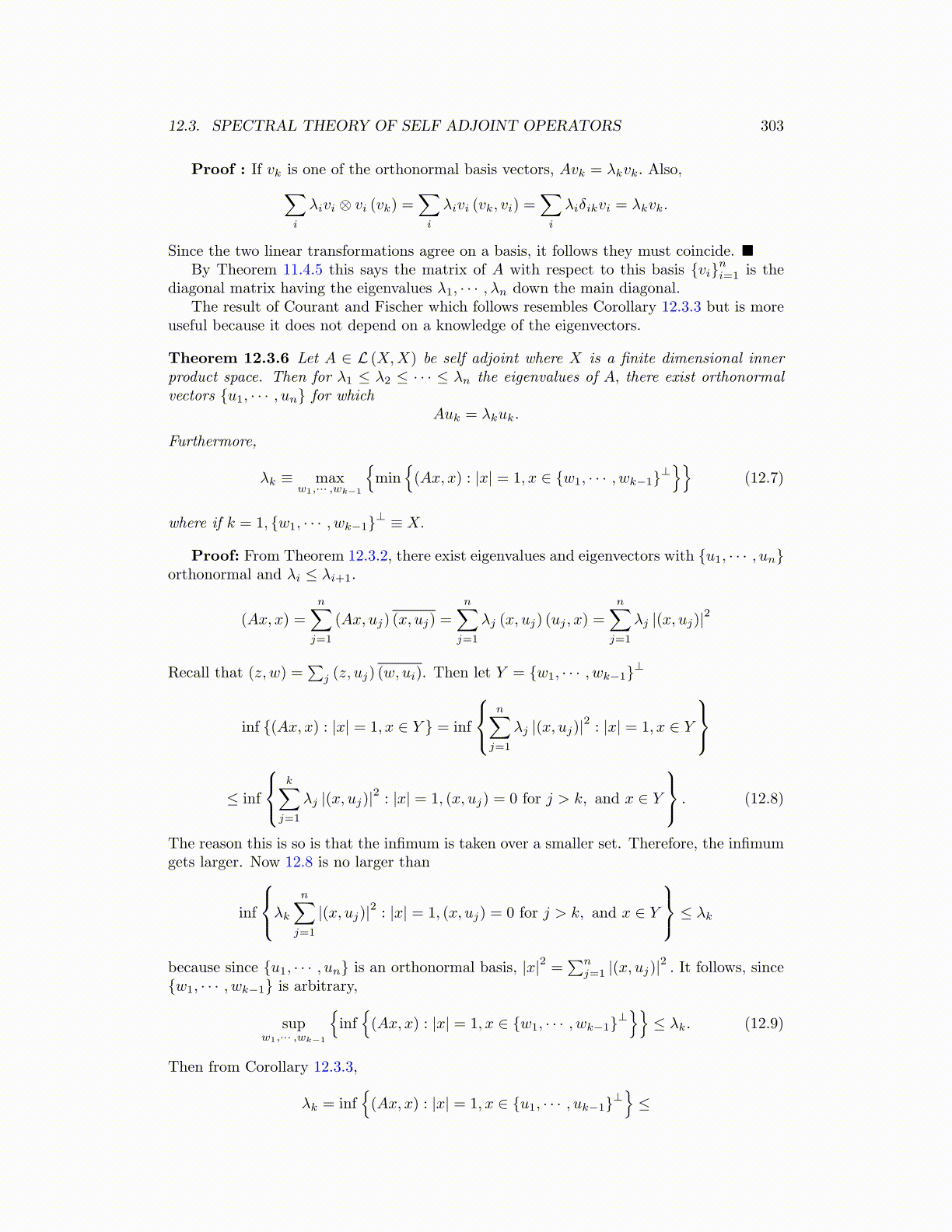
12.3. SPECTRAL THEORY OF SELF ADJOINT OPERATORS 303
Proof : If vk is one of the orthonormal basis vectors, Avk = λkvk. Also,∑i
λivi ⊗ vi (vk) =∑i
λivi (vk, vi) =∑i
λiδikvi = λkvk.
Since the two linear transformations agree on a basis, it follows they must coincide. ■By Theorem 11.4.5 this says the matrix of A with respect to this basis {vi}ni=1 is the
diagonal matrix having the eigenvalues λ1, · · · , λn down the main diagonal.The result of Courant and Fischer which follows resembles Corollary 12.3.3 but is more
useful because it does not depend on a knowledge of the eigenvectors.
Theorem 12.3.6 Let A ∈ L (X,X) be self adjoint where X is a finite dimensional innerproduct space. Then for λ1 ≤ λ2 ≤ · · · ≤ λn the eigenvalues of A, there exist orthonormalvectors {u1, · · · , un} for which
Auk = λkuk.
Furthermore,
λk ≡ maxw1,··· ,wk−1
{min
{(Ax, x) : |x| = 1, x ∈ {w1, · · · , wk−1}⊥
}}(12.7)
where if k = 1, {w1, · · · , wk−1}⊥ ≡ X.
Proof: From Theorem 12.3.2, there exist eigenvalues and eigenvectors with {u1, · · · , un}orthonormal and λi ≤ λi+1.
(Ax, x) =
n∑j=1
(Ax, uj) (x, uj) =
n∑j=1
λj (x, uj) (uj , x) =
n∑j=1
λj |(x, uj)|2
Recall that (z, w) =∑
j (z, uj) (w, ui). Then let Y = {w1, · · · , wk−1}⊥
inf {(Ax, x) : |x| = 1, x ∈ Y } = inf
n∑
j=1
λj |(x, uj)|2 : |x| = 1, x ∈ Y
≤ inf
k∑
j=1
λj |(x, uj)|2 : |x| = 1, (x, uj) = 0 for j > k, and x ∈ Y
. (12.8)
The reason this is so is that the infimum is taken over a smaller set. Therefore, the infimumgets larger. Now 12.8 is no larger than
inf
λkn∑
j=1
|(x, uj)|2 : |x| = 1, (x, uj) = 0 for j > k, and x ∈ Y
≤ λk
because since {u1, · · · , un} is an orthonormal basis, |x|2 =∑n
j=1 |(x, uj)|2. It follows, since
{w1, · · · , wk−1} is arbitrary,
supw1,··· ,wk−1
{inf{(Ax, x) : |x| = 1, x ∈ {w1, · · · , wk−1}⊥
}}≤ λk. (12.9)
Then from Corollary 12.3.3,
λk = inf{(Ax, x) : |x| = 1, x ∈ {u1, · · · , uk−1}⊥
}≤